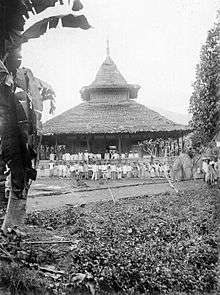Wapauwe Old Mosque
| Wapauwe Old Mosque | |
|---|---|
| Masjid Tua Wapauwe | |
 Wapauwe Mosque in early 20th-century | |
| Basic information | |
| Location | Kaitetu Village, Maluku, Indonesia |
| Geographic coordinates | 3°35′07″S 128°05′03″E / 3.585226°S 128.084243°ECoordinates: 3°35′07″S 128°05′03″E / 3.585226°S 128.084243°E |
| Affiliation | Islam |
| District | Leihitu Subdistrict |
| Province | Maluku |
| Status | Active |
| Architectural description | |
| Architectural type | Mosque |
| Architectural style | Vernacular Indonesian |
| Completed | 1414 |
| Length | 10 metres (33 ft) |
| Width | 10 metres (33 ft) |
| Materials | Thatched dried sago fronds |
Wapauwe Old Mosque (Indonesian Masjid Tua Wapauwe) is a historic mosque in Kaitetu village, on the north part of cape Keitetu, North Maluku, Indonesia. Established in 1414, it is the oldest mosque in the Moluccas and possibly the oldest mosque in Indonesia which has been maintained in its original state.[1][2]
History
Wapauwe Mosque is located in the historic village of Kaitetu where many remnants of Portuguese buildings lie such as a Portuguese church and a neglected Dutch fort. It was formerly a Portuguese trading post.[2]
According to a written record from 1464, the founder of the mosque was Jamilu, a Muslim priest and a descendant of the Sultanate of Jailolo in North Maluku. He arrived in Tanah Hitu around 1400 to spread Islam in Wawane and founded a mosque known as "Wawane Mosque". The Dutch arrived on Tanah Hitu in 1580, following the departure of the Portuguese in 1512. To avoid tension with the Dutch, the Wawane people decided to move away from their homeland. In 1614, they moved to Kampung Tehala, around 6 km east of Wawane. During the exodus, the Wawane Mosque was also relocated. Nowadays, local people still believe that the mosque moved magically by itself to Wapauwe.[1]
The first major renovation of the mosque was in 1664 when it was twice transported and rebuilt without any changes to its original appearance. In the beginning of the 18th century, a spire on top of the mosque was installed, symbolizing the Arabic letter alif sybolizing Allah.[1] The second major renovation was in 1895 when a porch was added to the front and to the east of the original mosque. Several minor renovations was undertaken after the Independence period without changing its appearance, the last in March 2008 when the roof thatch was renewed.[2]
Treasures of the mosque
The mosque kept one of the oldest Qur'anic mus'hafs in Indonesia; the oldest of these is a mus'haf written by Imam Muhammad Arikulapessy which was completed in 1550 with no miniature decoration. The other is a mus'haf by Nur Cahya, completed in 1590, also undecorated. There were also other historic manuscripts kept inside the mosque such as a Muslim calendar from Gregorian year 1407 and a manuscript for a Friday Prayer in year 1661. All these treasuries are now kept in the heritage house of Abdul Rachim Hatauwe, the twelfth descendant of Imam Muhammad Arikulapessy.[2]
Architecture
The original architecture of the mosque is still retained. The architectural style follows the typical traditional mosque architecture in Indonesia with a multitiered roof and no minaret. The mosque is about 10 x 10 meters, plus additional porch. The walls are covered in gaba-gaba (dried sago fronds) as well as the thatched roof.[2]
References
Works cited
- Friska Yolandha (14 April 2012). "Masjid Wapauwe: Rumah Allah Tertua di Indonesia Timur" [Wapauwe Mosque: Oldest House of Allah in East Indonesia]. Republika (in Indonesian). Jakarta. Retrieved 7 November 2015.
- Zein, Abdul Baqir (1999). Masjid-masjid bersejarah di Indonesia [Historic mosques in Indonesia] (in Indonesian). Gema Insani. ISBN 9789795615675.